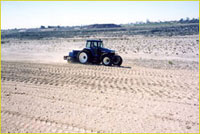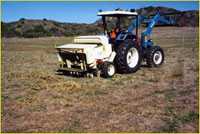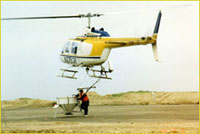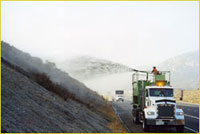|
SEED
IMPRINTING
Seed imprinting is primarily used in non-irrigated desert applications,
allowing minimal rainfall to be collected in troughs to help establish seedlings
which mature into perennial grasses in severely overgrazed rangelands in southwestern
deserts. It provides grazing for livestock and enhances the natural environment
while providing erosion control.
Nakae
and Associates, Inc. has designed a unique imprinter powered
by a 200-horse power tractor capable of making a ten-foot
pass. This specialty equipment creates troughs for planting
and is capable of applying seed, fertilizer and mycorrhizal
inoculum in a single application, maximizing utilization
of rainfall to help germinate seed and establish seedlings.
This method is not recommended in rocky conditions where
rocks prevent the imprinter from penetrating the soil.
| click
images to view larger
 
|
DRILL
SEEDING
Drill seeding is the preferred method of seed planting as the seed
is placed in the ground, providing more protection and contact with the soil.
It requires less seed. Seed metering and placement are the keys to success. Hard
slick seeds are metered differently than chaffy or fluffy seeds. Placing seed
in a seed furrow at a specified depth is difficult when some species need to be
placed at one depth while other species in the same mix germinate best when placed
on or near the surface. In
1998 Nakae and Associates, Inc. began work on a perimeter highway around Salt
Lake City, establishing 500 acres of native revegetation in a harsh terrain with
little natural precipitation. Using a specially designed seed drill and a special
drilling mix on the disturbed areas of the job, the land was drill seeded in the
fall and the seeds were able to thrive, achieving excellent root development and
vigorous germination in the spring. During
their years in business, Nakae and Associates, Inc. has used various types of
seeding procedures for different seed types, sometimes blending different types
of seed mixed with a carrier, or doing a combined seeding which required only
one application process. With Nakae's expertise, seeding can be accomplished in
existing vegetation or untilled conditions, working on slopes as steep as 2:1.
Drill seeding can be used in irrigated and non-irrigated applications. | click
images to view larger 
|
HYDROSEEDING
Hydroseeding consists of applying a "homogeneous slurry"
of wood fiber, seed, fertilizer, stabilizing products and
water. This method of seeding can be the solution to temporary
and permanent erosion control needs and is often used on
a construction project when permanent erosion control methods
cannot be completed prior to winter rains. Temporary applications
can be used to meet BMP (Best Management Practice) needs.
A permanent
application to meet particular BMP needs consists of the
specified seed mix with Bonded Fiber Matrix. Bonded Fiber
Matrix eliminates direct raindrop impact on the soil, insures
contact of seed to soil and has a high water retention capacity.
Straw
can be tackified to cut or fill slopes using fiber and binder. This method would
be used when straw is required but cannot be incorporated into the soil by straw
punching due to compaction of soil.
Turf,
grassland and shrub seed mixes can be applied by hydroseeding
with specified seed mixes combined with specified fertilizers,
fiber and water. Nakae's hydroseeders have a sufficient
capacity to do any size job, including areas with limited
access. They also do aerial seeding and fertilizing and
have other specialty equipment for specific seeding needs.
| click
images to view larger 
|